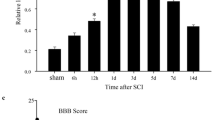Abstract
SENP3 (SUMO-specific proteases 3), a member of the small ubiquitin-like modifier specific protease family, was identified as a molecule that deconjugates SUMOylation of modified protein substrates and functions as an isopeptidase by disrupting SUMO homeostasis to facilitate cancer development and progression. However, its expression and function in nervous system injury and repair are still unclear. In this study, we employed an acute spinal cord injury (SCI) model in adult rats and investigated the dynamic changes of SENP3 expression in the spinal cord. Western blot analysis indicated a gradual increase in SENP3 expression, which peaked 3 days after SCI, and then declined over the following days. Immunohistochemistry results further confirmed that SENP3 was expressed at low levels in the gray and white matter in the non-injured condition and increased after SCI. Moreover, immunofluorescence double-labeling showed that SENP3 was co-expressed with the neuronal marker, NeuN. Furthermore, the SENP3-positive cells that were co-expressed with NeuN had also expressed active caspase-3 after injury. To investigate whether SENP3 plays a role in neuronal apoptosis, we applied H2O2 to induce neuronal apoptosis in vitro. Western blot analysis showed a significant upregulation of SENP3 and active caspase-3 following H2O2 stimulation. Taken together, these results suggest that SENP3 may play important roles in the pathophysiology of SCI.





Similar content being viewed by others
References
Johnson RL, Gabella BA, Gerhart KA (1997) Evaluating sources of traumatic spinal cord injury surveillance data in Colorado. Am J Epidemiol 146:266–272
Wells JE, Rice TK, Nuttall RK (2003) An adverse role for matrix metalloproteinase 12 after spinal cord injury in mice. J Neurosci 23:10107–10115
Dumont RJ, Okonkwo DO, Verma S (2001) Acute spinal cord injury, part I: pathophysiologic mechanisms. Clin Neuropharmacol 24:254–264
Cheng C, Gao S, Zhao J (2008) Spatiotemporal patterns of postsynaptic density (PSD)-95 expression after rat spinal cord injury. Neuropathol Appl Neurobiol 34:340–356
Byrnes KR, Stoica BA, Fricke S (2007) Cell cycle activation contributes to post-mitotic cell death and secondary damage after spinal cord injury. Brain 130:2977–2992
Di Giovanni S, Knoblach SM, Brandoli C (2003) Gene profiling in spinal cord injury shows role of cell cycle in neuronal death. Ann Neurol 53:454–468
Yun C, Wang Y, Mukhopadhyay D (2008) Nucleolar protein B23/nucleophosmin regulates the vertebrate SUMO pathway through SENP3 and SENP5 proteases. J Cell Biol 183:589–595
Bawa-Khalfe T, Yeh ET (2011) SUMO losing balance: SUMO proteases disrupt SUMO homeostasis to facilitate cancer development and progression. Genes Cancer 1:748–752
Yeh ET, Gong L, Kamitani T (2000) Ubiquitin-like proteins: new wines in new bottles. Gene 248:1–14
Muller S, Ledl A, Schmidt D (2004) SUMO: a regulator of gene expression and genome integrity. Oncogene 23:1998–2008
Rajan S, Plant LD, Rabin ML (2005) Sumoylation silences the plasma membrane leak K + channel K2P1. Cell 121:37–47
Cheng J, Wang D, Wang Z (2004) SENP1 enhances androgen receptor-dependent transcription through desumoylation of histone deacetylase 1. Mol Cell Biol 24:6021–6028
Yang SH, Jaffray E, Hay RT (2003) Dynamic interplay of the SUMO and ERK pathways in regulating Elk-1 transcriptional activity. Mol Cell 12:63–74
Gong L, Yeh ET (2006) Characterization of a family of nucleolar SUMO-specific proteases with preference for SUMO-2 or SUMO-3. J Biol Chem 281:15869–15877
Klein UR, Haindl M, Nigg EA (2009) RanBP2 and SENP3 function in a mitotic SUMO2/3 conjugation-deconjugation cycle on Borealin. Mol Biol Cell 20:410–418
Hay RT (2005) SUMO: a history of modification. Mol Cell 18:1–12
Gruner JA (1992) A monitored contusion model of spinal cord injury in the rat. J Neurotrauma 9:123–126 (discussion 126–128)
Fuenzalida K, Quintanilla R, Ramos p (2007) Peroxisome proliferator-activated receptor gamma up-regulates the Bcl-2 anti-apoptotic protein in neurons and induces mitochondrial stabilization and protection against oxidative stress and apoptosis. J Biol Chem 282:37006–37015
McEwen ML, Springer JE (2005) A mapping study of caspase-3 activation following acute spinal cord contusion in rats. J Histochem Cytochem 53:809–819
Teshima Y, Akao M, Li RA (2003) Mitochondrial ATP-sensitive potassium channel activation protects cerebellar granule neurons from apoptosis induced by oxidative stress. Stroke 34:1796–1802
Tator CH (1996) Experimental and clinical studies of the pathophysiology and management of acute spinal cord injury. J Spinal Cord Med 19:206–214
Jacobs TP, Shohami E, Baze W (1987) Deteriorating stroke model: histopathology, edema, and eicosanoid changes following spinal cord ischemia in rabbits. Stroke 18:741–750
Faden AI, Demediuk p, Panter SS (1989) The role of excitatory amino acids and NMDA receptors in traumatic brain injury. Science 244:798–800
Hall ED, Braughler JM (1993) Free radicals in CNS injury. Res Publ Assoc Res Nerv Ment Dis 71:81–105
Merrill JE, Ignarro LJ, Sherman MP (1993) Microglial cell cytotoxicity of oligodendrocytes is mediated through nitric oxide. J Immunol 151:2132–2141
Nishisho T, Tonai T, Tamura Y (1996) Experimental and clinical studies of eicosanoids in cerebrospinal fluid after spinal cord injury. Neurosurgery 39:950–956 (discussion 956–957)
Tan JA, Song J, Chen Y (2011) Phosphorylation-dependent interaction of SATB1 and PIAS1 directs SUMO-regulated caspase cleavage of SATB1. Mol Cell Biol 30:2823–2836
Tan JA, Sun Y, Song J (2008) SUMO conjugation to the matrix attachment region-binding protein, special AT-rich sequence-binding protein-1 (SATB1), targets SATB1 to promyelocytic nuclear bodies where it undergoes caspase cleavage. J Biol Chem 283:18124–18134
Shi W, Zhao W, Shen A (2011) Traumatic brain injury induces an up-regulation of Hs1-associated protein X-1 (Hax-1) in rat brain cortex. Neurochem Res 36:375–382
Rubin LL, Philpott KL, Brooks SF (1993) Apoptosis: the cell cycle and cell death. Curr Biol 3(6):391–394
Acknowledgments
This work was supported by the Natural Science Foundation of Zhejiang Province (No. Y2090545).
Author information
Authors and Affiliations
Corresponding author
Additional information
Haixiang Wei and Honglin Teng contributed equally to this work.
Rights and permissions
About this article
Cite this article
Wei, H., Teng, H., Huan, W. et al. An Upregulation of SENP3 After Spinal Cord Injury: Implications for Neuronal Apoptosis. Neurochem Res 37, 2758–2766 (2012). https://doi.org/10.1007/s11064-012-0869-z
Received:
Revised:
Accepted:
Published:
Issue Date:
DOI: https://doi.org/10.1007/s11064-012-0869-z




